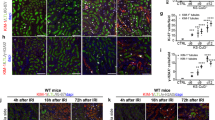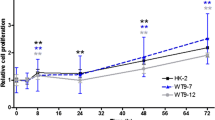Abstract
Autosomal recessive polycystic kidney disease (ARPKD) is caused by mutations in PKHD1, a gene encoding fibrocystin/polyductin (FC1), a membrane-associated receptor-like protein involved in the regulation of tubular cell adhesion, proliferation and apoptosis. Although it is generally accepted that apoptosis is implicated in ARPKD, the question of whether increased apoptosis is a normal response to abnormal cell proliferation or, instead, it is a primary event, is still subject to debate. In support of the latter hypothesis, we hereby provide evidence that apoptosis occurs in the absence of hyper-proliferation of FC1-depleted kidney cells. In fact, a decrease in cell proliferation, with a concomitant increase in apoptotic index and caspase-3 activity was observed in response to FC1-depletion by PKHD1 siRNA silencing in HEK293 and 4/5 tubular cells. FC1-depletion also induced reduction in ERK1/2 kinase activation, upregulation of the pro-apoptotic protein p53 and activation of NF-κB, a transcription factor which reduces apoptosis in many organs and tissues. Interestingly, selective inactivation of NF-κB using either an NF-κB decoy or parthenolide, a blocker of IKK-dependent NF-κB activation, reduced, rather then increased, apoptosis and p53 levels in FC1-depleted cells. Therefore, the proapoptotic function of NF-κB during cell death by FC1-depletion in kidney cells is evident.








Similar content being viewed by others
References
Guay-Woodford L (2003) Desmond R autosomal recessive polycystic kidney disease (ARPKD): the clinical experience in North America. Pediatrics 111:1072–1080
Zerres K, Rudnik-Schöneborn S, Senderek J, Eggermann T, Bergmann C (2003) Autosomal recessive polycystic kidney disease (ARPKD). J Nephrol 16:453–458
Menezes LF, Cai Y, Nagasawa Y et al (2004) Polyductin, the PKHD1 gene product, comprises isoforms expressed in plasma membrane, primary cilium, and cytoplasm. Kidney Int 66:1345–1355
Wang S, Zhang J, Nauli SM et al (2007) Fibrocystin/polyductin, found in the same protein complex with polycystin-2, regulates calcium responses in kidney epithelia. Mol Cell Biol 27:3241–3252
Harris PC, Torres VE (2009) Polycystic kidney disease. Annu Rev Med 60:321–337
Kuure S, Vuolteenaho R, Vainio S (2000) Kidney morphogenesis: cellular and molecular regulation. Mech Dev 92:31–45
Woo D (1995) Apoptosis and loss of renal tissue in polycystic kidney diseases. N Engl J Med 333:18–25
Kip SN, Hunter LW, Ren Q et al (2005) [Ca2+]i reduction increases cellular proliferation and apoptosis in vascular smooth muscle cells: relevance to the ADPKD phenotype. Circ Res 96:873–880
Bukanov NO, Smith LA, Klinger KW, Ledbetter SR, Ibraghimov-Beskrovnaya O (2006) Long-lasting arrest of murine polycystic kidney disease with CDK inhibitor roscovitine. Nature 444:949–952
Starremans PG, Li X, Finnerty PE, Guo L et al (2008) A mouse model for polycystic kidney disease through a somatic in-frame deletion in the 5′ end of Pkd1. Kidney Int 73:1394–1405
Goilav B, Satlin LM, Wilson PD (2008) Pathways of apoptosis in human autosomal recessive and autosomal dominant polycystic kidney diseases. Pediatr Nephrol 23:1473–1482
Shen HM, Tergaonkar V (2009) NFkappaB signaling in carcinogenesis and as a potential molecular target for cancer therapy. Apoptosis 14:348–363
Grimm S, Bauer MK, Baeuerle PA (1996) Schulze-Osthoff K.Bcl-2 down-regulates the activity of transcription factor NF-kappaB induced upon apoptosis. J Cell Biol 134:13–23
Baichwal VR, Baeuerle PA (1997) Activate NF-kappa B or die? Curr Biol 7:R94–R96
Burstein E, Duckett CS (2003) Dying for NF-kappaB? Control of cell death by transcriptional regulation of the apoptotic machinery. Curr Opin Cell Biol 15:732–737
Aguiari G, Trimi V, Bogo M et al (2008) Novel role for polycystin-1 in modulating cell proliferation through calcium oscillations in kidney cells. Cell Prolif 41:554–573
Wang S, Luo Y, Wilson PD, Witman GB, Zhou J (2004) The autosomal recessive polycystic kidney disease protein is localized to primary cilia, with concentration in the basal body area. J Am Soc Nephrol 15:592–602
Nagano J, Kitamura K, Hujer KM et al (2005) Fibrocystin interacts with CAML, a protein involved in Ca2+ signaling. Biochem Biophys Res Commun 338:880–889
Aguiari G, Varani K, Bogo M et al (2009) Deficiency of polycystic kidney disease-1 gene (PKD1) expression increases A(3) adenosine receptors in human renal cells: Implications for cAMP-dependent signalling and proliferation of PKD1-mutated cystic cells. Biochim Biophys Acta 1792:531–540
Ward CJ, Yuan D, Masyuk TV et al (2003) Cellular and subcellular localization of the ARPKD protein; fibrocystin is expressed on primary cilia. Hum Mol Genet 12:2703–2710
Aguiari G, Banzi M, Gessi S et al (2004) Deficiency of polycystin-2 reduces Ca2+ channel activity and cell proliferation in ADPKD lymphoblastoid cells. FASEB J 18:884–886
Aguiari G, Campanella M, Manzati E et al (2003) Expression of polycystin-1 C-terminal fragment enhances the ATP-induced Ca2+ release in human kidney cells. Biochem Biophys Res Commun 301:657–664
Manzati E, Aguiari G, Banzi M et al (2005) The cytoplasmic C-terminus of polycystin-1 increases cell proliferation in kidney epithelial cells through serum-activated and Ca(2+)-dependent pathway(s). Exp Cell Res 304:391–406
Guijarro C, Egido J (2001) Transcription factor-kappa B (NF-kappa B) and renal disease. Kidney Int 59:415–424
Zhang S, Lin ZN, Yang CF, Shi X, Ong CN, Shen HM (2004) Suppressed NF-kappaB and sustained JNK activation contribute to the sensitization effect of parthenolide to TNF-alpha-induced apoptosis in human cancer cells. Carcinogenesis 25:2191–2199
Borgatti M, Finotti A, Romanelli A et al (2004) Peptide nucleic acids (PNA)-DNA chimeras targeting transcription factors as a tool to modify gene expression. Curr Drug Targets 5:735–744
Kim I, Fu Y, Hui K et al (2008) Fibrocystin/polyductin modulates renal tubular formation by regulating polycystin-2 expression and function. J Am Soc Nephrol 19:455–468
Wegierski T, Steffl D, Kopp C et al (2009) TRPP2 channels regulate apoptosis through the Ca2+ concentration in the endoplasmic reticulum. EMBO J 28:490–499
Lanoix J, D’Agati V, Szabolcs M, Trudel M (1996) Dysregulation of cellular proliferation and apoptosis mediates human autosomal dominant polycystic kidney disease (ADPKD). Oncogene 13:1153–1160
Boletta A, Qian F, Onuchic LF, Bhunia AK et al (2000) Polycystin-1, the gene product of PKD1, induces resistance to apoptosis and spontaneous tubulogenesis in MDCK cells. Mol Cell 6:1267–1273
Tao Y, Kim J, Faubel S et al (2005) Caspase inhibition reduces tubular apoptosis and proliferation and slows disease progression in polycystic kidney disease. Proc Natl Acad Sci USA 102:6954–6959
Woods JS, Ellis ME, Dieguez-Acuña FJ, Corral J (1999) Activation of NF-kappaB in normal rat kidney epithelial (NRK52E) cells is mediated via a redox-insensitive, calcium-dependent pathway. Toxicol Appl Pharmacol 154:219–227
Dieguez-Acuña FJ, Polk WW, Ellis ME, Simmonds PL, Kushleika JV, Woods JS (2004) Nuclear factor kappaB activity determines the sensitivity of kidney epithelial cells to apoptosis: implications for mercury-induced renal failure. Toxicol Sci 82:114–123
Edelstein CL (2005) What is the role of tubular epithelial cell apoptosis in polycystic kidney disease (PKD)? Cell Cycle 4:1550–1554
Torres VE, Harris PC (2006) Mechanisms of disease: autosomal dominant and recessive polycystic kidney diseases. Nat Clin Pract Nephrol 2:40–55
Mai W, Chen D, Ding T et al (2005) Inhibition of Pkhd1 impairs tubulomorphogenesis of cultured IMCD cells. Mol Biol Cell 16:4398–4409
Cance WG, Golubovskaya VM (2008) Focal adhesion kinase versus p53: apoptosis or survival? Sci Signal 1(20):pe22
Yang J, Zhang S, Zhou Q et al (2007) PKHD1 gene silencing may cause cell abnormal proliferation through modulation of intracellular calcium in autosomal recessive polycystic kidney disease. J Biochem Mol Biol 40:467–474
Wu H, Lozano G (1994) NF-kappa B activation of p53. A potential mechanism for suppressing cell growth in response to stress. J Biol Chem 269:20067–20074
Ryan KM, Ernst MK, Rice NR, Vousden KH (2000) Role of NF-kappaB in p53-mediated programmed cell death. Nature 404:892–897
Kim I, Li C, Liang D et al (2008) Polycystin-2 expression is regulated by a PC2-binding domain in the intracellular portion of fibrocystin. J Biol Chem 283:31559–31566
Pinton P, Giorgi C, Siviero R, Zecchini E, Rizzuto R (2008) Calcium and apoptosis: ER-mitochondria Ca2+ transfer in the control of apoptosis. Oncogene 27:6407–6418
Morrissey J, Klahr S (1998) Transcription factor NF-kappaB regulation of renal fibrosis during ureteral obstruction. Semin Nephrol 18:603–611
Tamada S, Asai T, Kuwabara N et al (2006) Molecular mechanisms and therapeutic strategies of chronic renal injury: the role of nuclear factor kappaB activation in the development of renal fibrosis. J Pharmacol Sci 100:17–21
Guzik TJ (2007) Harrison DG.Endothelial NF-kappaB as a mediator of kidney damage: the missing link between systemic vascular and renal disease? Circ Res 101:227–229
Acknowledgments
We thank Dr. Johannes A. Schmid (Medical University, Vienna, Austria) for providing NFkB-GFP plasmid, Anna Forster for correcting the manuscript and I. Maestri and A. Canella for technical assistance. This work was supported by Cassa di Risparmio di Ferrara, Cassa di Risparmio di Cento, Italian MIUR COFIN 2008 and Regione Emilia Romagna (Ricerca Regione-Università) 2007–2009.
Author information
Authors and Affiliations
Corresponding author
Electronic supplementary material
Below is the link to the electronic supplementary material.
Rights and permissions
About this article
Cite this article
Mangolini, A., Bogo, M., Durante, C. et al. NF-κB activation is required for apoptosis in fibrocystin/polyductin-depleted kidney epithelial cells. Apoptosis 15, 94–104 (2010). https://doi.org/10.1007/s10495-009-0426-7
Published:
Issue Date:
DOI: https://doi.org/10.1007/s10495-009-0426-7




